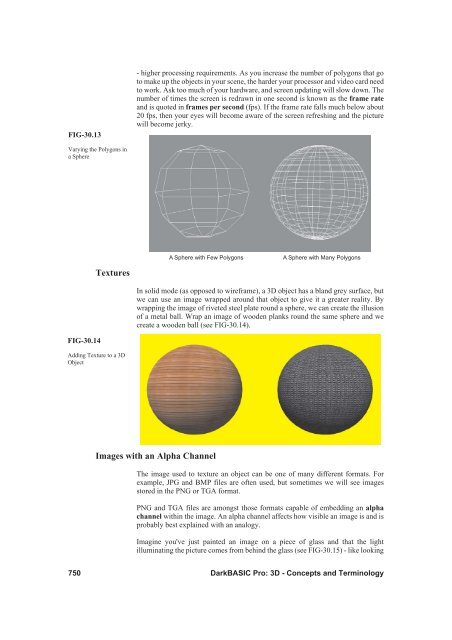Hands On DarkBASIC Pro - Digital Skills
Hands On DarkBASIC Pro - Digital Skills
Hands On DarkBASIC Pro - Digital Skills
Create successful ePaper yourself
Turn your PDF publications into a flip-book with our unique Google optimized e-Paper software.
FIG-30.13<br />
Varying the Polygons in<br />
a Sphere<br />
FIG-30.14<br />
Textures<br />
Adding Texture to a 3D<br />
Object<br />
- higher processing requirements. As you increase the number of polygons that go<br />
to make up the objects in your scene, the harder your processor and video card need<br />
to work. Ask too much of your hardware, and screen updating will slow down. The<br />
number of times the screen is redrawn in one second is known as the frame rate<br />
and is quoted in frames per second (fps). If the frame rate falls much below about<br />
20 fps, then your eyes will become aware of the screen refreshing and the picture<br />
will become jerky.<br />
In solid mode (as opposed to wireframe), a 3D object has a bland grey surface, but<br />
we can use an image wrapped around that object to give it a greater reality. By<br />
wrapping the image of riveted steel plate round a sphere, we can create the illusion<br />
of a metal ball. Wrap an image of wooden planks round the same sphere and we<br />
create a wooden ball (see FIG-30.14).<br />
Images with an Alpha Channel<br />
A Sphere with Few Polygons A Sphere with Many Polygons<br />
The image used to texture an object can be one of many different formats. For<br />
example, JPG and BMP files are often used, but sometimes we will see images<br />
stored in the PNG or TGA format.<br />
PNG and TGA files are amongst those formats capable of embedding an alpha<br />
channel within the image. An alpha channel affects how visible an image is and is<br />
probably best explained with an analogy.<br />
Imagine you've just painted an image on a piece of glass and that the light<br />
illuminating the picture comes from behind the glass (see FIG-30.15) - like looking<br />
750 <strong>DarkBASIC</strong> <strong>Pro</strong>: 3D - Concepts and Terminology


